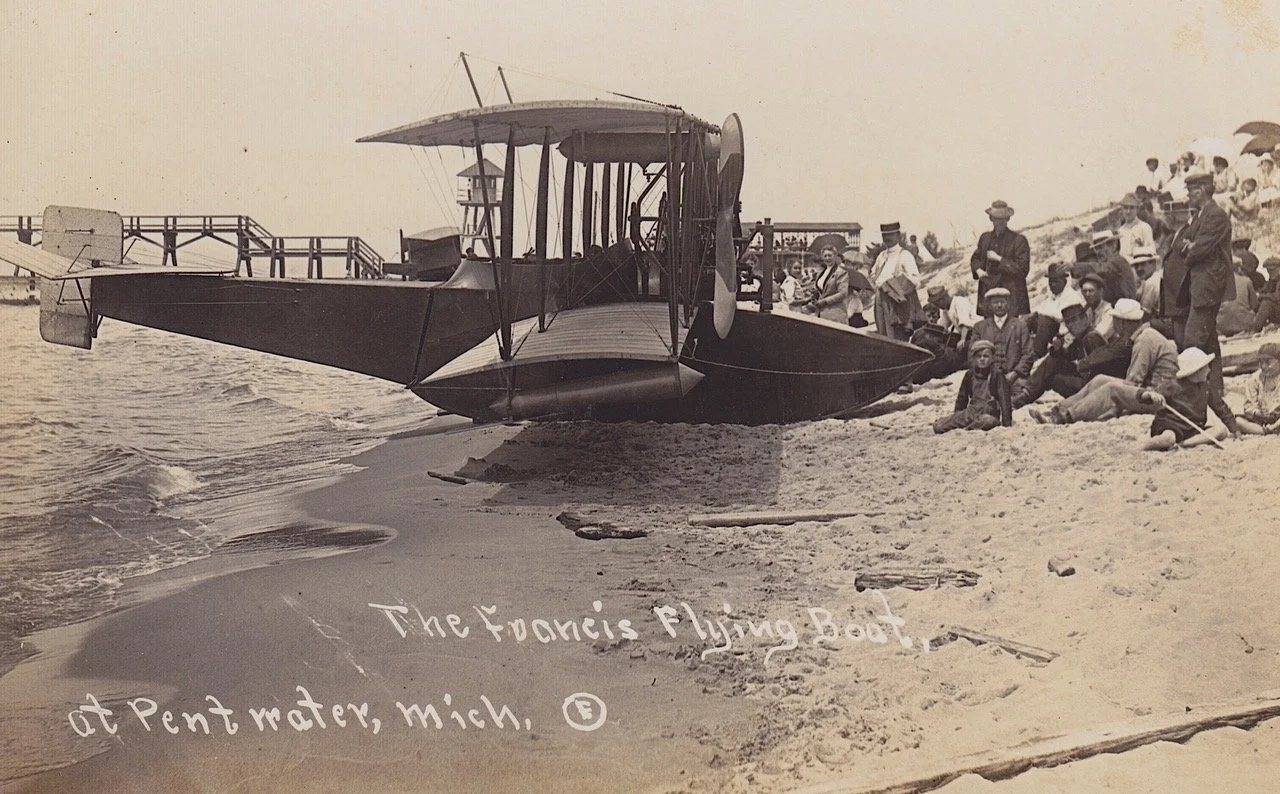THE FRANCIS FLYING BOAT - Great Lakes Reliability Cruse July 8 to July 18, 1913
Pentwater Building Stories —The Flying Boat Race July 8 - 18, 1913
In July 1913, at Juniper Beach just south of Pentwater, Roy Francis of San Francisco landed his flying boat accompanied by a passenger, former parachutist "Sky High" James Irving. Francis was part of the Great Lakes Reliability Contest, the world's most fantastic flying boat race, sponsored by the Illinois Aero Club and Aero and Hydro Magazine. Seven pilots entered the race at Chicago's Grant Park on July 8, 1913. It was an 884-mile journey from Illinois around the shoreline of Michigan's lower peninsula to the Detroit Boat Club for fame and a giant trophy. Due to take-off mishaps and the stormy weather, only three flying boats raced. In 1913, the flying boats, in production for under two years, were wooden-hulled with wings and could fly along the lake cruising at 60-70 miles per hour. They had a tail, a large rear-facing propeller, and a gasoline engine. Good fuel was expensive and hard to find so the pilots hoped to made extra money at exhibitions and barnstorming events scheduled for the race stops, Michigan City, Manistee, Petoskey, and Mackinaw. That did not happen.
The first flying boat to make Michigan City was a state-of-the-art Curtiss flying boat with pilot Beckwith Havens at the helm. He was accompanied by J.B.R. VerPlanck, a wealthy farmer from Fishkill, New York state, who was the aircraft's owner. The pair met up with pilot Roy Francis at Macatawa Bay in Holland. The third competitor also made it to Macatawa. He was Glen L. Martin, owner of the Martin Company, builder of famous planes like the Martin Marauder, the Martin Mars, the PBM, and the China Clipper. Havens and Francis then flew on to Pentwater. There, General Sears, a Pentwater Booster Club member and owner of the Sears & Nichols Canning Company, organized a dinner for the visitors. Havens and VerPlanck then left for Charlevoix. VerPlanck, had a second control panel so the pilot could rest during the flight. Roy Francis attempted unsuccessfully to take off from Pentwater and finally shipped his craft back to Chicago. Martin had stopped in Muskegon, made repairs, and taken onlookers on flights over Muskegon Lake. When he finally reached Pentwater, he had repair issues and dropped out of the race. Beckwith Havens, now the lone race competitor, headed northward around the Straits of Mackinaw and stopped in Cheboygan, Bay City, and Port Huron. Finally, a day late, on July 18, 1913, Havens and VerPlanck landed on the beach of the Detroit Motorboat Club. There, crowds greeted them, and factory whistles blew. Haven won the big trophy and achieved a new aviation milestone. Pentwater earned a place in history.
